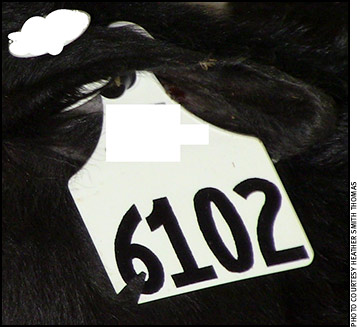Keep Records for Drug Withdrawal Times
Keep these tips in mind for easy recordkeeping on drug withdrawal times.

Ear tags can help producers keep track of withdrawal times of medications.
When a food animal is given medication, it takes a certain amount of time for the body to break it down and eliminate it. During that period, the animal should not enter the food chain.
Different drugs or medications have different withdrawal times before slaughter. This waiting time is to make sure any residue left in the meat is below the Food and Drug Administration’s (FDA’s) maximum residue limit. Withdrawal times are on the label. Some kind of record system is needed to keep track of withdrawal times on products for each of those animals.
Shannon Williams, Lemhi County Extension educator and Beef Quality Assurance (BQA) Coordinator for Idaho, says most people use cell phones that have multiple features, including reminders, and could put withdrawal times into their phone calendar.
People generally need reminders, even if things are written down or on the computer. It’s easy to lose track of dates.
“Your kitchen calendar works, if it’s something you look at all the time,” says Williams.
“Another strategy is a visual reminder on the animal itself — to tag or write the withdrawal date on the existing ear tag with a marking pen. Then, if someone else is working cattle, there’s no question about which animals were treated and what the withdrawal date is,” she says.
Some people notch the ear tag when they treat an animal, but then have to look at their records to know when it was treated, with what and the withdrawal time.
“One of the requirements for organic or natural producers is to identify any animal treated with antibiotics. Those animals are usually given another ear tag (to differentiate from the others) so they can be removed from the program. Then if the producer is making a load to send to market, the tag is obvious, so those animals don’t get loaded,” Williams says.
If you put a date on that tag, you know how long it would have to be before that individual could be marketed a different way.
Another tactic Williams suggests would be to paint the animal on the shoulder with the date. Paint markings, like what is used with sheep or cows when preg-testing, stay legible for a long time. A visual aid on the animal can be helpful, especially when working or sorting cattle. You don’t always take your kitchen calendar to the corral when making sorting decisions.
Most people have phones with them. Even if they don’t use the calendar function, there is also a note function. They can pull up the numbers they need to be watching for, says Williams.
These tactics can be handy for any large operation where a person might be treating multiple animals throughout the year. One crew may not know what the other crew did, so there’s a need for good records and easy ways to identify these animals.
“Even in a small operation, there’s always a chance you may not be there when cattle are sorted and loaded. You need a system that someone else can pick up and make it work. If we can’t be there for loading, we have to make sure that the sale is still made and the correct cattle get loaded, and the buyer is still happy,” says Williams.
On a small operation, you might know everything about the cattle and have it all in your head. But if you are unexpectedly gone, someone else is doing your chores, and this may include making decisions about the cattle. Maybe there’s room for another animal on the load and you need to choose one to fill the load; you need to know immediately which one to select and not make a mistake.
“Even if you put reminders on your phone, you probably need two systems. Then if you are gone, you don’t have all the records with you (on your phone or in a pocket notebook),” Williams warns. “You need a backup, such as a list you can text, or a calendar in the barn. A simple method would be a notebook or calendar that stays chuteside (in a zippered bag to keep it dry) with treatment information. Usually your loading chute isn’t far from your working chute, and a person could check treatment records quickly without having to go back to the house for the kitchen calendar.”

Editor’s Note: Heather Smith Thomas is a cattlewoman and freelance writer from Salmon, Idaho.






